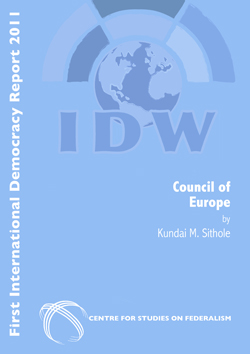Council of Europe
by Kundai M. Sithole University of Reading, UK
|
|
|
Table of contents
1. Introduction
2. Origins of the Council of Europe
3. Institutions
3.1. The Committee of Ministers3.1.1. Mandate
3.1.2. Procedures
3.2. The Parliamentary Assembly
3.2.1. Composition
3.2.2. Mandate
4. Democracy at the national level
4.1. Stabilising the regional neighbourhood4.2. Stabilising the transition to democracy
4.3. Promoting democracy within the member states
5. Input legitimacy
5.1. Civil society representation and participation5.2. Legal framework for civil society participation
5.2.1. Convention on the Recognition of the Legal Personality of INGOs
5.2.2. Fundamental Principles on the Status of NGOs in Europe
5.2.3. Recommendation on the Legal Status of NGOs in Europe
5.3. Institutional framework for civil society participation
5.3.1. Conference of International Non-governmental Organisations
5.3.2. Standing Committee of the Conference of INGOs
5.3.3. Civil Society Initiatives
6. Democracy and rights in Europe
6.1. The Council of Europe’s human rights mandate6.2. Institutions and human rights protection
6.2.1. The Committee of Ministers and the Parliamentary Assembly
6.2.2. The European Commissioner for Human Rights
6.2.3. The Directorate General for Human Rights and Legal Affairs
6.2.4. The European Commission for Democracy through Law
6.2.5. The European Court of Human Rights
6.3. Human rights pillars
6.3.1. The European Convention on Human Rights
6.3.2. The Revised European Social Charter
6.3.3. The European Convention for the Prevention of Torture
6.3.4. The Framework Convention on National Minorities
7. Supranationalism and output legitimacy
7.1. Democracy in the Council of Europe7.1.1. Democratic representation and democratic control
7.1.2. Appraising the Assembly’s democratic influence in the Council of Europe
7.1.3. Democracy through rights and the European Court of Human Rights
7.2. Institutional permeability and democratic participation
7.2.1. Range of actors
7.2.2. Organisational information and decision-making levels
7.3. Appraising NGO participation and democracy in the Council of Europe
7.3.1. Policy venue and NGO ideological missions
7.3.2. Is there a real ‘quadrilogue’ in the Council of Europe?

